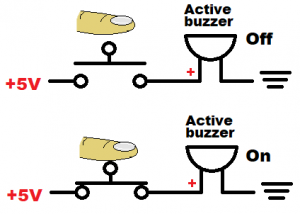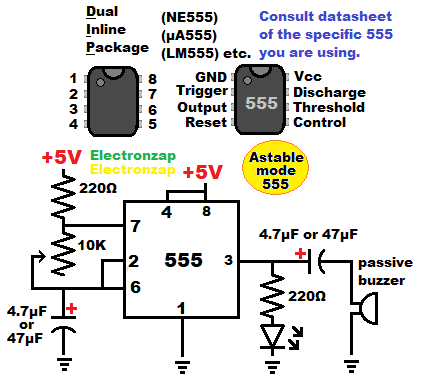Table of Contents
Active buzzers just need a steady voltage to buzz, whereas passive buzzers need a rapidly changing voltage to buzz.
Active buzzer:

The active buzzer is pretty simple. Simply put 5 volts (if it is a 5V buzzer) across it, and it emits a loud high pitch tone.
It turns off when power is cut off.
Passive buzzer:

The passive buzzer needs a changing voltage to make sound.
The 555 timer wired in astable mode, and a coupling capacitor, alternates current through the passive buzzer without letting a continuous (DC) current flow through it.
Frequency of alternations can be adjusted by using the trimpot or other potentiometer.
Slow alternations results in clicks. I also added an LED to the example circuit, for a visual indication of turning on or off with each click.
At higher frequencies, the passive buzzer buzzes. The pitch of the buzz gets higher as the frequency gets higher.
To support this site, check out the following links:
- Become a Patron!
- Check out my YouTube videos! https://www.youtube.com/c/Electronzap/videos
- Products I used in my videos or otherwise think look like a good buy. As an Amazon associate, I earn from qualifying purchases. https://www.amazon.com/shop/electronzapdotcom
- Information on this site is not guaranteed to be accurate. Always consult the manufacturer info/datasheet of parts you use. Research the proper safety precautions for everything you do.
- Electronzap is a participant in the Amazon Services LLC Associates Program, an affiliate advertising program designed to provide a means for sites to earn advertising fees by advertising and linking to amazon.com.